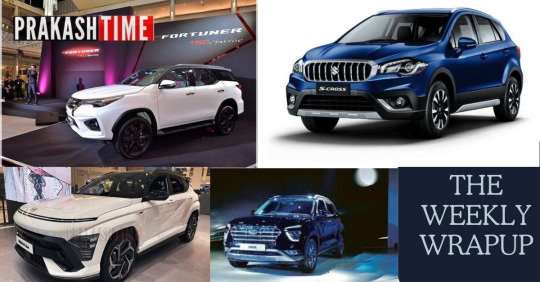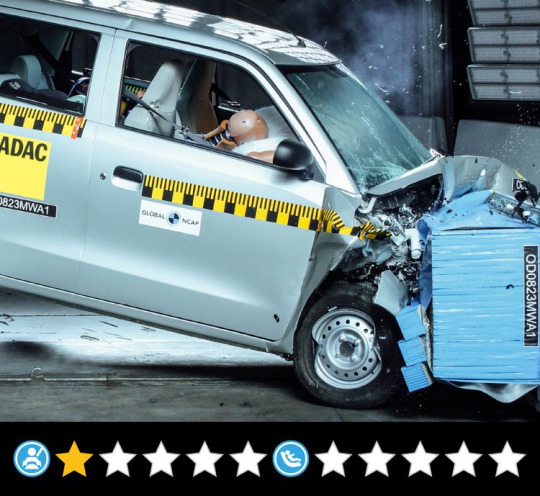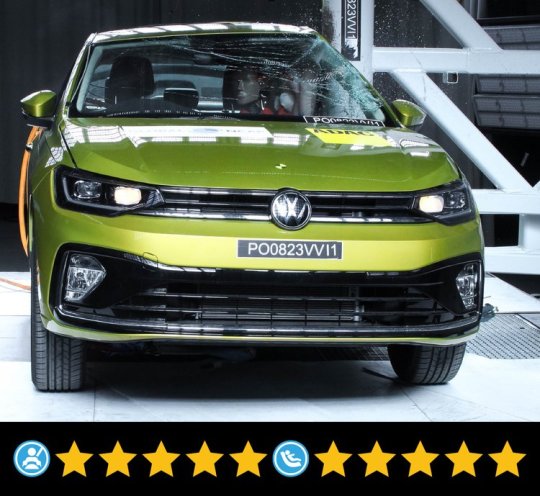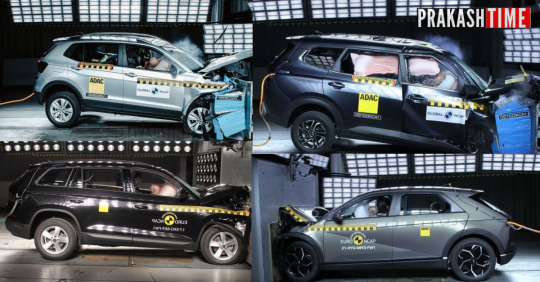#Global NCAP
Text

HOT WHEELS: TOP STORIES SHAPING THE AUTO INDUSTRY LAST WEEK FEBRUARY 12-16
Prices for Tata electric cars have gone down over the last week, and Global NCAP has released the results of their crash tests on the updated Tata Nexon.
Follow for more information Prakashtime.com
0 notes
Text
Maruti Suzuki Alto और Wagen R का क्रेश टेस्ट में मिली है 0 Saftey रेटिंग ,जाने क्या कहा कंपनी ने
🚗🌟BREAKING NEWS🌟🚗 Maruti Suzuki responds to the Global NCAP crash test rating for the Alto K10 and WagonR. While the cars did not receive a perfect rating, #MarutiSuzuki #AltoK10 #WagonR #GlobalNCAP #crashtest #safety #India
Maruti Suzuki Alto and Wagen R Safety Rating: एक समय था जब Maruti suzuki की कार को लोग आँख बंद करके खरीद लेते थे और कंपनी का भारतीय बाज़ार में दबदबा था , लेकिन जब से Global NCAP ने अपनी क्रेश टेस्ट रिपोर्ट्स को रिलीज़ करना शुरू किया है ,सेफ्टी के मामलो में मारुती के कारो की पहचान कमजोर कार के रूप में हो गयी है |
Global NCAP ने अभी हाल ही में मारुति सुजुकी की दो पॉपुलर कार ‘Alto K10’ और ‘Wagen R’…

View On WordPress
#0 safety rating#alto k10 safety rating#CRASH TEST REPORT#Global NCAP#Maruti suxuki alto k10#Maruti Suzuki#maruti wagen r#safety rating#wagen r safety ratig
0 notes
Text
Safety in cars has taken some major steps ahead in India since Global NCAP first began crash-testing Indian cars. Over the years, new rules have arrived into place making dual airbags and ABS required, with more safety restrictions expected to also be raised in the future. Safety ratings, too have enhanced from the dismal performance of 2014 with the first five-star rated car arriving in 2018 and the number now up to five. We take a look at the best 5 safest made-in-India cars presently on the market in 2022.
0 notes
Text
सेफ्टी के मामले में पीछे रह गई Kia Carens, देखें क्रैश टेस्ट में मिले कितने स्टार?
सेफ्टी के मामले में पीछे रह गई Kia Carens, देखें क्रैश टेस्ट में मिले कितने स्टार?
नई दिल्ली. कोरियाई कार निर्माता किआ (Kia) की ओर से साल की शुरुआत में लॉन्च की गई 7-सीटर कार कैरेंस (Kia Carens) को सेफ्टी के मामले में बड़ा झटका लगा है. हाल ही में इसे Global NCAP क्रैश टेस्ट में सिर्फ 3-स्टार रेटिंग मिली है. इस मॉडल को एडल्ट और चाइल्ड पैसेंजर दोनों की सेफ्टी के लिहाज से 3-स्टार मिले हैं.
Kia Carens एक मेड इन इंडिया कार है. जिसमें सभी बेसिक सेफ्टी फीचर्स मिलते हैं. इसमें…
View On WordPress
0 notes
Text
Mahindra XUV700 receives Global NCAP’s ‘Safer Choice’ Award
Mahindra XUV700 receives Global NCAP’s ‘Safer Choice’ Award
Mahindra & Mahindra Ltd., pioneers of the SUV segment in India, announced that their hugely successful XUV700 received the Global NCAP ‘Safer Choice’ Award for being the safest car in India. This accolade is only available to automakers achieving the highest levels of safety for vehicles sold in India. This achievement is even more special for Mahindra as it won this award two times in a row,…

View On WordPress
0 notes
Text
This is the new Dacia Spring 2025
Over the years, Dacia Spring has become a well-known name in the world of affordable electric cars and the PHP Rent a Car Cluj Napoca Airport office reminds you that this model launched for the first time in 2021 managed to attract the attention of consumers through its innovative concept: simple electric mobility and effective at an affordable price. With over 140,000 units sold globally to date, Dacia Spring has established itself as a popular choice for those looking for zero-emission mobility solutions. Initially, its launch in 2021 was rewarded with success, ranking third in the top electric car sales for retail customers in 2022 and 2023. With its energy efficiency and low carbon footprint, Dacia Spring achieved in 2022 the assessment maximum 5 stars from the independent European organization Green NCAP:
6 notes
·
View notes
Link
The Honda Amaze, a popular sub-compact sedan in India, recently underwent crash testing by Global NCAP. While the 2019 model achieved a respectable 4-star rating for adult occupant protection, the results for the 2024 model paint a concerning picture. The latest iteration scored only 2 stars in adult occupant protection and a dismal 0 stars for child occupant safety. Let's delve deeper into this decline in safety ratings and explore the reasons behind it. Honda Amaze Crash Test Results A Tale of Two Amaze: Evolution (or Regression) Over Time The Honda Amaze debuted in the Indian market in 2013, offering a choice between a 1.2-liter petrol engine and a 1.5-liter diesel engine. Back then, crucial safety features like dual front airbags and even ABS (Anti-lock Braking System) with EBD (Electronic Brake-force Distribution) were not standard equipment. The year 2018 witnessed the launch of the second-generation Amaze in India, with exports to other markets like South Africa. This iteration underwent crash testing by Global NCAP in 2019, securing a 4-star rating for adult occupant protection and a single star for child occupant safety. The same year saw the inclusion of dual front airbags, ABS with EBD, and ISOFIX child seat anchorages as standard features. Fast forward to 2021, and the second-generation Amaze received a facelift with minor design tweaks and additional features. This is the model currently available for purchase. While its safety equipment now includes dual front airbags, ABS with EBD, and a seatbelt reminder for all seats as standard, the recent Global NCAP results raise serious concerns. Global NCAP's Shifting Landscape: Raising the Bar for Safety Previously, Global NCAP's crash testing for Indian cars primarily focused on the presence of front airbags, ABS, and overall structural integrity. The evaluation involved only frontal offset barrier crash tests, with ratings assigned in two categories: adult occupant protection (out of 17 points) and child occupant protection (out of 49 points). However, 2022 marked a significant shift as Global NCAP implemented stricter assessment protocols. The current testing regime goes beyond the frontal offset test, incorporating side impact, side pole impact, and pedestrian protection evaluations. Furthermore, achieving the coveted 5-star rating now necessitates several additional safety features as standard equipment, including electronic stability control (ESC), six airbags, and ISOFIX child seat anchorages. The adult occupant protection score has also been revamped, with points awarded on a scale of 34. A Closer Look at the Honda Amaze's Crash Test Performance Adult Occupant Protection (AOP): A Missed Opportunity While both the 2019 and 2024 Amaze models offered "good" protection for the driver and front passenger's head and neck in the frontal impact test, their chest protection ratings were categorized as "adequate." Both versions also exhibited "marginal" protection for the knees of the driver and front passenger. Encouragingly, the body shell integrity and footwell area in both the 2019 and 2024 Amaze were rated as stable. However, a critical factor contributing to the 2024 model's disappointing AOP rating is the omission of essential safety features like ESC and side curtain airbags, which are now mandatory under the latest Global NCAP protocol. Child Occupant Protection (COP): A Cause for Concern The 2019 Amaze utilized ISOFIX child seats for the 3-year-old child in the forward-facing position. While these seats prevented excessive forward movement during the impact, the child's head was exposed during the rebound, and the chest experienced high loads. For the 18-month-old child, the rearward-facing child seat malfunctioned upon impact, rotating the system and causing head exposure. The 2024 model, while using ISOFIX anchorages for the 3-year-old child's forward-facing seat, didn't entirely prevent head contact with the car's interior. In the case of the 18-month-old, the rearward-facing child seat failed to provide adequate protection or prevent ejection, resulting in a zero score for this crucial test. Frequently Asked Questions: Q: Why did the Honda Amaze's crash test ratings drop from 4 stars to 2 stars in adult occupant protection? A: The decline in safety ratings can be attributed to the omission of crucial safety features such as electronic stability control (ESC) and side curtain airbags in the 2024 version. Q: What caused the decrease in child occupant protection ratings from 1 star to zero stars? A: Changes in child seat installation methods and inadequate protection mechanisms in the 2024 version led to the decline in child occupant safety ratings. Q: Why did the Honda Amaze's safety rating decline in the 2024 Global NCAP crash test? A: The 2024 Amaze received a lower rating compared to the 2019 model due to the omission of crucial safety features like ESC and side curtain airbags, which are now mandatory under the latest Global NCAP protocols. Q: What are some of the safety features missing in the 2024 Honda Amaze? A: The 2024 Honda Amaze lacks essential safety features like electronic stability control (ESC) and side curtain airbags, both of which are now mandatory for achieving a good safety rating in the latest Global NCAP tests.
#adultoccupantprotection#childoccupantprotection#ElectronicStabilityControlESC#GlobalNCAPCrashTest#HondaAmaze#ISOFIXChildSeatAnchorages#safetyrating#SideCurtainAirbags
0 notes
Text
El Citroën ë-C3 de la India se estrella en los test de Global NCAP
Cuando una marca crea un nuevo modelo uno de los apartados más importantes es la seguridad. Sus ingenieros trabajan para... http://dlvr.it/T56SBL
0 notes
Text
Climate Change & Sustainability Services in India
In the midst of escalating climate concerns and growing awareness about sustainability, the demand for innovative solutions has never been more urgent. India, a country experiencing the brunt of climate change impacts, stands at the forefront of this global challenge. However, amidst adversity lies opportunity. This blog explores the pioneering efforts in Climate Change & Sustainability Services in India, highlighting unique approaches and initiatives aimed at fostering a greener, more resilient future.
Understanding the Landscape: India, with its diverse ecosystems and burgeoning population, faces multifaceted challenges stemming from climate change. From erratic monsoons to rising sea levels, the implications are profound. Recognizing the need for concerted action, various stakeholders, including government bodies, businesses, and civil society, are mobilizing efforts to address these challenges.
Unique Initiatives:
Community-led Adaptation Projects: In rural areas prone to climate risks, community-driven initiatives are making significant strides. From watershed management programs to afforestation drives, local communities are spearheading efforts to build resilience against climate impacts. Organizations like The Watershed Organisation Trust (WOTR) are empowering communities through sustainable agriculture practices and water management techniques.
Corporate Sustainability Innovations: Indian corporations are increasingly integrating sustainability into their core business strategies. Leading conglomerates such as Tata Group and Reliance Industries are investing in renewable energy projects, reducing carbon emissions, and implementing circular economy principles. Through initiatives like the Tata Sustainability Group and Reliance Foundation, these companies are setting benchmarks for sustainable business practices.
Green Finance and Investment: Recognizing the importance of financing sustainable development, India has witnessed a surge in green finance mechanisms. From green bonds to impact investing, financial institutions are channeling funds towards climate-resilient projects. Organizations like the Indian Renewable Energy Development Agency (IREDA) are playing a pivotal role in facilitating investments in renewable energy and clean technology ventures.
Technology-driven Solutions: With the advent of digital technologies, innovative solutions are emerging to address climate challenges. Start-ups and tech companies are leveraging artificial intelligence, Internet of Things (IoT), and blockchain to enhance resource efficiency, monitor environmental parameters, and optimize energy consumption. Platforms like Climate Connect are leveraging data analytics to provide actionable insights for climate risk management and mitigation strategies.
Policy and Advocacy Efforts: Government policies and regulatory frameworks play a crucial role in driving sustainability agendas. India's National Action Plan on Climate Change (NAPCC) outlines strategies for mitigation and adaptation across various sectors. Additionally, initiatives like the National Clean Air Programme (NCAP) and the Smart Cities Mission are aimed at improving air quality and promoting sustainable urban development.
Challenges and Opportunities: While significant progress has been made, challenges persist on the path towards sustainability. Issues such as policy implementation bottlenecks, funding constraints, and socio-economic disparities pose formidable obstacles. However, these challenges also present opportunities for innovation, collaboration, and collective action. By harnessing the creativity and resilience of its people, India can pave the way for transformative change in the global fight against climate change.
Conclusion: In the face of unprecedented environmental challenges, India is forging ahead with bold and innovative solutions. From grassroots initiatives to corporate leadership and technological innovations, the landscape of Climate Change & Sustainability Services in India is characterized by diversity, dynamism, and determination. As we navigate the complexities of a changing climate, let us draw inspiration from these pioneering efforts and work together towards a more sustainable and resilient future for generations to come.
1 note
·
View note
Text
6 Reasons Why Municipal Corporations Should Be on the Frontlines of India’s Air Pollution Battle

Air pollution remains a pressing concern in India, with 18 out of the 20 most polluted cities globally. Despite the Union government's efforts, a significant reduction in pollution levels is yet to be witnessed. The key to making tangible progress lies in empowering municipal corporations and district subdivision administrations, which handle approximately 60% of on-the-ground activities mandated by programs like the National Clean Air Programme (NCAP). Here are six compelling reasons why municipal corporations should take the lead in India's battle against air pollution:
Local Engagement for Hyperlocal Solutions:
Municipal corporations need to place citizens, civil society, and industries at the core of interventions to mitigate air pollution. Local governments must actively engage with citizens, utilizing tech interfaces for reporting incidents and encouraging volunteerism. Guwahati's successful collaboration with civil society in door-to-door waste collection and disposal of biomedical waste serves as a model that should be identified and scaled up.
Capacity Building for Effective Action:
Municipal corporations and district subdivision administrations, alongside Pollution Control Boards (PCBs), require well-trained human resources and adequate infrastructure to effectively tackle air pollution. While information on visible pollution sources is generally up-to-date, capacity-building programs are crucial to equip officials with the skills needed to implement feasible local solutions.
Revisiting Finance Commission Grants:
The indicators and framework for the 15th Finance Commission grants need revision to induce sustainable changes at the community level. The current system, which ties grants to improvements in air quality, discourages essential investments in monitoring frameworks. A more balanced approach is needed to ensure that cities aren't pushed into deprivation and don't compromise on reported data in the pursuit of incentives.
Customized Approaches for Unique Cities:
Every city is unique, influenced by factors such as population, economic activities, and geography. Each city must identify its local sources of pollution through source apportionment and emission inventory studies. Despite NCAP mandates, only 37 out of 132 non-attainment cities have completed such studies. Reinforcing the need for these local studies is essential for crafting effective, customized strategies to combat air pollution.
Dynamic Governance for Dynamic Challenges:
Air pollution control demands a collaborative inter-sectoral and decentralized governance approach. By enhancing the efficiency of municipal corporations, India can better address the dynamic nature of air pollution challenges. A focus on dynamic governance ensures adaptability to changing circumstances and the ability to implement effective solutions promptly.
Leveraging the 74th Amendment:
The 74th amendment provides a basic framework for the decentralization of powers to municipal bodies. Identifying and addressing specific gaps hindering the realization of this amendment is crucial. Tailored capacity-building efforts in these areas will empower municipal bodies, allowing them to efficiently allocate resources for essential services like education, healthcare, and safe drinking water, ultimately improving citizens' quality of life.
In conclusion, putting municipal corporations at the forefront of India's air pollution battle is not just a strategic move but a necessity. It requires a multifaceted approach, including citizen engagement, capacity building, financial restructuring, and customized strategies for each city. By empowering local bodies, India can pave the way for a cleaner and healthier future for its citizens.
0 notes
Text
Volkswagen Virtus and Skoda Slavia Sedans Achieve Perfect 5-Star Safety Rating at Global NCAP, Making Them the Safest Cars in India!""
🚗🌟BREAKING NEWS🌟🚗 The Volkswagen Virtus and Skoda Slavia have both earned a perfect 5-star safety rating from Global NCAP! These sedans are now officially the safest cars in India! #safestcars #Volkswagen #Skoda #GlobalNCAP #5starsafety #india
Volkswagen Virtus and Skoda Slavia sedans have received 5-Star safety ratings from Global-NCAP for Adult and Child Occupant Protection, making them some of the safest sedans available in India.
Both the sedans share the same MQB-A0 IN platform as the Volkswagen Taigun and Skoda Kushaq SUVs, which have also received 5-Star safety ratings from Global-NCAP, with top-tier safety features and…

View On WordPress
#5 star safety rating#auto news#Global NCAP#gncap#NEWS#safest sedan car in India#safety rating#skoda slavia#volkswagen virtus
0 notes
Text

TATA NEXON: THEN AND NOW – A GLOBAL NCAP CRASH TEST COMPARISON
The updated Tata Nexon maintains its 5-star safety rating, now even more impressive in 2024 than in 2018.
follow for more information Prakashtime.com
0 notes
Text
0 notes
Video
youtube
2024 Tata Nexon | ⭐⭐⭐⭐⭐ | Global NCAP | Crash Test
0 notes
Text
Electric Cars Under 15 Lakhs In India – Best Cars with Key Specs

Embarking on a journey toward sustainable and efficient mobility, the electric vehicle market in India under 15 lakhs has witnessed a surge of eco-friendly marvels. These vehicles not only redefine our approach to commuting but also provide a budget-friendly avenue for environmentally conscious consumers. From stylish designs to cutting-edge technology, each electric car encapsulates the promise of a cleaner and smarter driving experience.
The Citroen eC3, priced at Rs. 11.5 Lakhs, stands out as a captivating embodiment of performance and efficiency. Fueled by a robust 29.2 kWh battery, its electric motor boasts 55 horsepower and accelerates from 0 to 100 kmph in just 9.0 seconds. With a remarkable range of 320 km on a single charge and efficient charging reaching 80% in 57 minutes, the e-C3 redefines urban commuting with practicality and eco-friendliness. Its immersive interior, distinctive colors, and modernity position it as a trendsetter in the electric vehicle market.
The Tata Tigor EV, priced at Rs. 12.5 Lakhs, offers impressive fast-charging capability, achieving an 80% charge in just 60 minutes with a 25kW DC charger. With a claimed range of 315 kilometers and competitive pricing, the Tigor EV provides a distinctive electric driving experience, balancing performance and battery conservation. The safety features, including a 4-star Global NCAP crash rating, showcase Tata's commitment to safety.
Tata Nexon EV Prime, priced at Rs. 15 Lakhs, boasts a contemporary design with a powerful 127 bhp motor, reaching a top speed of 120 kmph. With an impressive claimed range of 312 km on a single charge and convenient charging options, it offers an unparalleled driving experience. The premium interior, advanced features, and safety assurances make it one of the safest electric cars under 15 lakhs.
In conclusion, as India embraces eco-friendly and budget-conscious commuting, these electric cars under 15 lakhs emerge as the beacons of a promising automotive future. With compelling options from established automakers, these vehicles transform the way we drive, providing a practical and sustainable solution for modern urban dwellers. As the nation gears up for a greener future, affordable electric cars are at the forefront, shaping a new era of driving that cares for both consumers and the environment.
To read more, click here.
0 notes
Link
The Honda Amaze, a popular subcompact sedan in India, has recently undergone a fresh round of safety assessments by the Global New Car Assessment Program (Global NCAP). While initial expectations might have leaned towards positive results, Amaze's performance in the latest tests paints a concerning picture. This article delves into the details of the crash tests, analyzes the Amaze's performance in both adult and child occupant protection, and explores the safety features offered by the car. Honda Amaze Undergoes Global NCAP A Step Back in Safety: Lower Ratings Compared to 2019 It's important to acknowledge that this isn't Amaze's first encounter with Global NCAP testing. Back in 2019, the South Africa-spec Amaze secured a respectable 4-star safety rating. However, the recent tests conducted under the program's updated protocols reveal a significant decline in safety performance. The 2023 Amaze received a mere 2-star rating for Adult Occupant Protection (AOP) and a disheartening 0-star rating for Child Occupant Protection (COP). This decline can be attributed to the stricter testing procedures implemented by Global NCAP. The new protocols place a greater emphasis on crucial safety features like Electronic Stability Control (ESC) and side curtain airbags, both of which are absent in the tested Amaze variant. Dissecting the Results: A Closer Look at Adult and Child Occupant Protection Let's break down the Amaze's performance in each protection category: Adult Occupant Protection (AOP) - 2 Stars (27.85 points out of 34) The Amaze managed a score of 27.85 points out of a possible 34 in the AOP tests. Here's a breakdown of its performance in different impact scenarios: Frontal Impact (64 km): The car offered "good" protection for the driver and co-driver's heads and necks during the frontal crash test. Chest protection was deemed "adequate" for both occupants. However, the knees of both the driver and passenger received a "marginal" protection rating, while their tibias fared better with a "good" score. Side Impact (50 km): While the head and pelvis received "good" protection in the side impact test, the chest showed "marginal" protection and the abdomen received an "adequate" rating. Side Pole Impact: This test couldn't be conducted due to the unavailability of side curtain airbags in the tested variant. Child Occupant Protection (COP) - 0 Star (8.58 points out of 49) The Amaze's performance in the COP tests was particularly concerning, with a meager score of 8.58 points out of 49. Here's a glimpse into the specific results: Frontal Impact (64 km): The child restraint systems (CRS) used for both the 18-month-old and 3-year-old dummies offered inadequate protection. The 3-year-old dummy, seated in a forward-facing child seat, sustained excessive head contact with the vehicle's interior during the impact. The 18-month-old dummy, placed in a rearward-facing CRS, also failed to receive sufficient protection. Side Impact (50 km): The CRSs, however, managed to offer full protection to the child dummies during the side impact test. A Stable Bodyshell, But Crucial Features Missing Despite the disappointing safety scores, the Amaze did receive a positive note on its bodyshell integrity and footwell area. Global NCAP's report suggests that the car's bodyshell can withstand significant impact forces. However, this doesn't negate the critical role played by active safety features like ESC and side curtain airbags, which were absent in the tested variant. The lack of these features significantly compromises occupant safety in various collision scenarios. ESC helps maintain vehicle stability during critical maneuvers, while side curtain airbags provide additional head and chest protection during side impacts. Standard Safety Features and Honda's Response The Honda Amaze comes equipped with basic safety features such as dual front airbags, Anti-lock Braking System (ABS) with Electronic Brake-force Distribution (EBD), rear parking sensors, and ISOFIX child seat anchorages. It's important to note that the tested variant did not include seat belt reminders for all seats, although this feature is now available in the updated Amaze model. FAQs: Q: What safety features does the Honda Amaze offer? A: The Honda Amaze includes dual front airbags, ABS with EBD, rear parking sensors, and ISOFIX child seat anchors. However, it lacks electronic stability control (ESC) and side curtain airbags. Q: How does the Honda Amaze perform in crash tests? A: The recent Global NCAP evaluation awarded the Honda Amaze a 2-star safety rating for adult occupant protection and a 0-star rating for child occupant protection. Q: What steps is Honda taking to address safety concerns? A: Honda is committed to enhancing vehicle safety and integrating advanced safety technologies across its model range to ensure optimal protection for occupants.
#adultoccupantprotection#BodyshellIntegrity#childoccupantprotection#crashtest#FootwellAssessment#GlobalNCAP#HondaAmaze#HondaAmazeUndergoesGlobalNCAP#safetyfeatures#safetyrating
0 notes